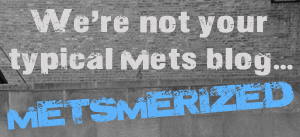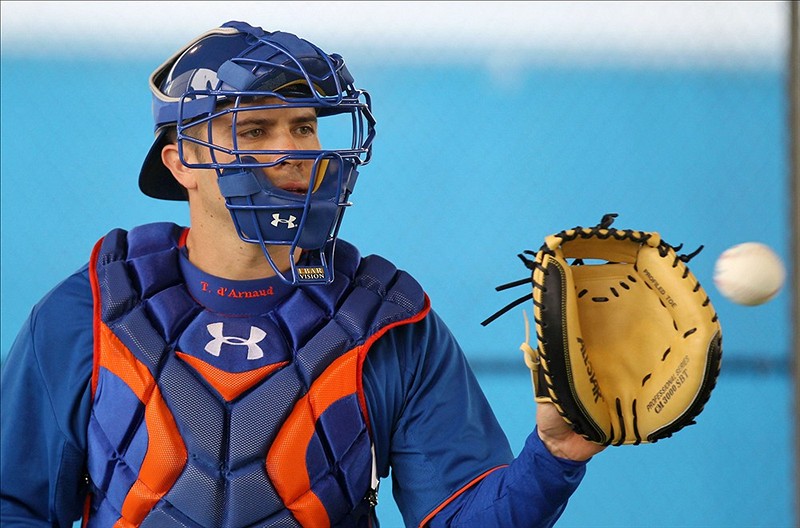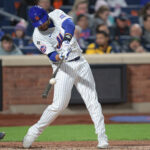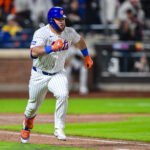Welcome to my annual player projection series. In this series, I will try to take a swing at estimating how each Met will do in the upcoming season. As the results of last year’s projections will tell you, I won’t be too accurate. So much happens over the course of a baseball season that without access to heavy data, (and the time and programming knowledge to analyze it), that even well thought-out projections could look laughable at the end of a season. Nonetheless, it is a great way to discuss in detail about each player. How will I go about doing this? Here are some of the tools I will use.
- Historical statistics of each player
- Computer Projections (Steamer, ZiPS, etc.)
- Indicators (xFIP, HR/FB, BABIP, Pitch f/x etc.)
- Visual analysis (Swing/Pitch mechanics and trends)
- News and notes
Hopefully, we’ll be able to get to each player this year. Enjoy the series!
Travis d’Arnaud, C
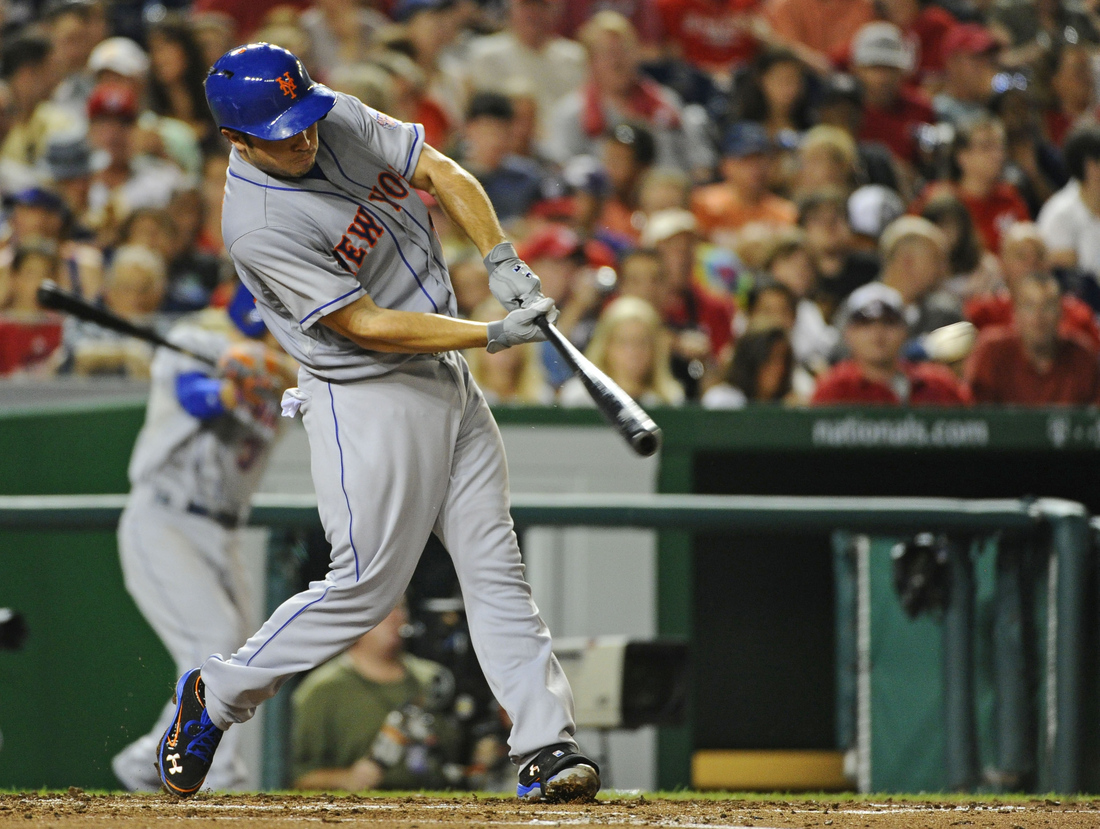
Photo: Brad Mills, USA TODAY Sports
The Mets are a team filled with promising young prospects, ones they hope will carry them to a winning future. One of the most important pieces for this year and beyond is Travis d’Arnaud, a 25 year-old catcher and top-rated prospect.
d’Arnaud was ranked the 30th-best prospect in baseball by Baseball America before last season, and was the top position player prospect in the Met farm system. He was due to receive significant playing time with the big league club, but after fracturing a bone in his foot in an April Triple-A game, that got pushed back. After a few setbacks, he was finally able to join the Mets in mid-August, when he would take over for the soon-to-be-traded John Buck.
In 112 plate appearances with the Mets, d’Arnaud struggled, posting a .202/.286/.263 slash line, ending the season with just four extra base-hits.
There were some bright spots for the young catcher, however, as he impressed the coaching staff and pitchers with his game-calling ability and certain aspects of his defensive game. Specifically, he did an impressive job with pitch-framing, and, as ESPN’s Mark Simon and Adam Rubin pointed out, was among some of the best pitch-framers in baseball during his short time with the team.
Although he struggled at the dish, there is still plenty of optimism surrounding d’Arnaud. For one, the sample size from last year is very small, so small that he will maintain his rookie status this year. That sample size may have also been his adjustment period after his injury, playing 20 minor league games, most of them below Triple-A. While this may seem like I’m making excuses for d’Arnaud, it’s more so pointing out the circumstances in which those sliver of at-bats were a part of. He may have hit terribly in his limited time, but that hasn’t dismayed any of the scouts that have raved about him in the past.
To get a good idea of d’Arnaud’s potential, I’ve compiled a few snippets from expert reports on him.
John Sickels (Minor League Ball):
Offensively, his best tool is power. He was rather impatient early in his career but has made progress with the strike zone. He looked dramatically improved in that department for Vegas this spring and summer, when he wasn’t hurt anyway. His power usually comes when he pulls the ball, although he is more willing to take something the opposite way than he was earlier in his career.
I don’t see him as a .300 hitter at the major league level, but he should be good for a solid .250-.270 range, with an adequate OBP and better-than-average power. He could exceed those projections in his peak seasons.
Although I don’t see him in the Buster Posey or Joe Mauer class of superstar catcher, d’Arnaud produces quality play on both sides of the ball. If he can avoid getting hurt too often, d’Arnaud will be a fixture in the Mets lineup for years to come,
Mark Anderson/Brett Sayre (Baseball Prospectus):
D’Arnaud is a complete catching prospect, and the only thing standing between him and several All-Star appearances is his ability to stay healthy and on the field. Offensively, d’Arnaud has plus bat speed and a knack for hard contact that should allow him to hit at least .280 in the big leagues once he settles in. He likes to swing the bat and will chase out of the strike zone at times, but he demonstrates just enough restraint for his natural hitting ability to shine through. When he makes contact, he consistently drives the ball to all fields and has the potential to pop 18-22 home runs and around 30 doubles at his peak.
D’Arnaud does a good job of receiving the baseball, handling velocity and secondary pitches with aplomb and demonstrating an ability to block pitches in the dirt. He isn’t fast, but his feet work quickly behind the plate, and he can get in position to unleash his plus arm with ease. D’Arnaud has consistently popped in the sub-2.0 second range, making him a threat to control the running game. Overall, d’Arnaud owns a robust skill set that will play on both sides of the ball. His ceiling stands squarely in the plus regular range and he could be a perennial All-Star when it all comes together.
The 24-year-old d’Arnaud stands out the most for his prowess at the plate, and he keeps getting better and better. A career .286/.347/.476 hitter in the Minors, he has boosted his OPS from .726 in high Class A to .906 in Double-A to .990 in Triple-A. d’Arnaud’s best pure tool is his above-average right-handed power, which he generates with a combination of bat speed and strength, and he could smash 20 homers annually in the Major Leagues.
d’Arnaud shows a feel for hitting as well, and his compact swing and all-fields approach should translate to solid batting averages as well. He could stand to draw a few more walks, but he has made progress with his plate discipline as he has risen through the Minors. d’Arnaud very well could produce .275/.340/.500 lines year in and year out in the Major Leagues.
Yes, even after the injury, experts are still high on d’Arnaud, even, as we see with Callis’ thoughts, after his hitting woes last season.
The computer projections are just as, if not more optimistic than the prospect experts. While it’s still early for projections to come out as rosters aren’t quite set, the ones that are out have d’Arnaud as an above-average starter this year. Here’s a look at what the Steamer projections have him doing:
105 G, 428 PA, 13 HR, 8.3 BB%, 18.9 K%, .254/.320/.418, 2.6 fWAR
This is interesting, as it has d’Arnaud missing some time. Projections are never good for predicting injury, so what will it be if it is averaged out to 140 games?
140 G, 570 PA, 17 HR, 8.3 BB%, 18.9 K%, .254/.320/.418, 2.8 fWAR
That’s a very good season, especially for a catcher. In last year’s rankings, that fWAR of 2.8 would be 11th among MLB catchers, and his home run total would be ninth. Now let’s look at the Oliver projections:
143 G, 600 PA,16 HR, 9.0 BB%, 24.7 K%, .241/.312/.397, 3.1 fWAR
This projection is interesting, as it has d’Arnaud having a worse offensive season than what the Steamer numbers say, but also having a higher overall value. Looking deeper, that’s because Oliver has him six runs better defensively.
Finally, we have the always-conservative ZiPS projections. For some reason, these always undershoot, so bear that in mind:
336 PA, 9 HR, 7.4 BB%, 24.1 K%, .245/.307/.392, 1.6 zWAR
Averaged out to 550 PA: 15 HR, 7.4 BB%, 24.1 K%, .245/.307/.392, 2.6 zWAR
Even these projections, which have David Wright accumulating just a 4.4 WAR next season, are rather optimistic on d’Arnaud. Both the scouts and the sabermetricians agree: d’Arnaud is due for a solid season.
Given a full spring training with a roster spot in-hand, as well as a full, injury-free offseason, I don’t see any reason not to be optimistic for d’Arnaud this year. His defensive abilities are there, and although he didn’t show it in limited time last year, his hitting is too. Just because of the dimensions of Citi Field and having to go through a full-season, I’m going to be a little conservative on the power numbers, but still within the range of the computer projections. However, I’d like to come full circle and talk about d’Arnaud’s pitch framing one last time.
Measuring a catcher’s worth is still difficult for statisticians when it comes to defense. d’Arnaud’s pitch framing abilities as well as his game-calling have been lauded by the Mets coaching staff and pitchers. Neither of those are incorporated into WAR as of now, so he adds intangible value as well, or at least that’ what has been the case so far.
Tangibly or intangibly, this season looks to be a strong one for the young catcher.
MMO 2014 Projection:
550 PA, 15 HR, 8.0 BB%, 22.0 K%, .245/.310/.405, 2.8 fWAR
